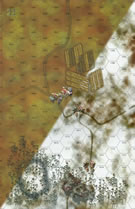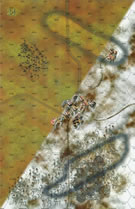|
No Time Maple Leaf Brigade #1 |
||
|---|---|---|
| (Defender) Canada | vs | Soviet Union (Attacker) |
| Formations Involved | ||
|---|---|---|
| Canada |  |
27th Brigade Group |
| Soviet Union |  |
207th "Berlinskaya" Rifle Division |

| Total | |
|---|---|
| Side 1 | 1 |
| Draw | 0 |
| Side 2 | 0 |
| Overall Rating, 1 vote |
|---|
|
4
|
| Scenario Rank: --- of 913 |
| Parent Game | Maple Leaf Brigade |
|---|---|
| Historicity | Alt-History |
| Date | 1951-10-01 |
| Start Time | 08:00 |
| Turn Count | 20 |
| Visibility | Day |
| Counters | 121 |
| Net Morale | 1 |
| Net Initiative | 1 |
| Maps | 2: 22, 24 |
| Layout Dimensions | 56 x 43 cm 22 x 17 in |
| Play Bounty | 188 |
| AAR Bounty | 171 |
| Total Plays | 1 |
| Total AARs | 1 |
| Battle Types |
|---|
| Exit the Battle Area |
| Inflict Enemy Casualties |
| Meeting Engagement |
| Urban Assault |
| Conditions |
|---|
| Off-board Artillery |
| Scenario Requirements & Playability | |
|---|---|
| Elsenborn Ridge | Maps |
| Hammer & Sickle | Counters |
| Maple Leaf Brigade | Base Game |
| Road to Berlin | Counters |
| Introduction |
|---|
|
Rushed to Germany during the summer of 1950, the Canadian 27th Brigade Group had had no time for large unit exercises. But many of its men and almost all of its officers had combat experience, and as volunteers their morale was excellent even if their equipment was not. When troops of the Soviet 3rd Shock Army smashed through the border fences and began their drive on Hannover, the Canadians – already seen as the British Army of the Rhine’s “fire brigade” – hopped into their Kangaroos and went into action. |
| Conclusion |
|---|
|
While the Soviets spearheaded their attack with regular divisions, the Soviet Army (formerly the Red Army) remained a conscript force and at a decided disadvantage in terms of morale and unit cohesion when faced with the Canadian volunteers. Even though the Soviets had tank support and the Canadians did not, it was the Soviet division that reeled back with a bloody nose from this first encounter. Nevertheless, during the early phases of the offensive, NATO units were very lightly sprinkled throughout the operational area. Any breakthrough would have a significant impact on the cohesion of the BAOR front and it was essential to not only fight the Soviet units to a standstill but to take the initiative away. Each Soviet unit which lost the will to advance was one that NATO and the BAOR could ignore in the short term. |
| AFV Rules Pertaining to this Scenario's Order of Battle |
|---|
|
| 2 Errata Items | |
|---|---|

|
The reduced direct fire value in Kursk: Burning Tigers is 4-4. (plloyd1010
on 2015 Jul 31)
|

|
Kommissars never get morale or combat modifiers. Ignore misprints. (Shad
on 2010 Dec 15)
|
| Blame Canada |
|---|
|
If the Soviets ever attacked Western Europe and failed to achieve their objectives, you can be certain it would have been due to the stout defense of the Canadian Army. In this scenario, two Soviet mechanized battalions stiffened with a reinforced company of T44s attacked a mechanized battalion of Canadians. It was essentially a meeting engagement, with both sides moving onto the map at start of play. The Canadians had to defend some towns and try to prevent Soviets exiting the Canadian edge. The Canadian plan was to deploy companies of infantry in the south and central city areas, with a further company deployed in the fields to the north. They had two good AT guns backing their line. The Soviets came on with their two battalions attacking in parallel in the center and northern sectors, with 2 platoons of T44s supporting each battalion. They deployed a scratch machine gun battalion cobbled together from the two infantry battalions in the south. The wheels came off the Soviet bus pretty rapidly. The Canadian occupied their positions with alacrity and were ready for their attackers. The Soviet attack in the center moved ahead with support from all the tanks while the northern battalion loitered for an hour or so. The MGs in the south deployed aggressively to take the southern town but suffered heavy casualties in the approach. In the center the attack became pretty disorganized but contact was achieved under cover of smoke. The tanks were steadily getting popped by the AT guns. The center battalion expended itself pretty uselessly, their poor morale and leadership not allowing any offensive moves once they were in contact. The northern battalion made a dash for the weak left flank of the Canadian position but was harassed by artillery fire, and halted by the Canadians reserve of two platoons. As the southern and central Soviet thrusts withered, spirited Canadian counterattacks rolled up both forces and drove into the flank of the now disorganized northern force. The Soviet Kommisar fled, demoralized. Multiple overruns and extended assaults by Canadians in Kangaroos ended the Soviet attack after only 2.5 hours. Major Canadian victory. |
| 0 Comments |

 LZog004
LZog004 


























